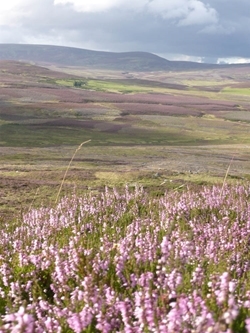 For many years, the GWCT and others have used a figure of 75% for the proportion of upland heather moorland found in the UK. The view that the UK contains 75% of the world’s heather moorland has been widely accepted, being found uncited in a range of articles, for example the Ecologist, the RSPB website, and the Climate News Network, as well as in books. The basis of this estimate has been queried recently and we discuss it here.
For many years, the GWCT and others have used a figure of 75% for the proportion of upland heather moorland found in the UK. The view that the UK contains 75% of the world’s heather moorland has been widely accepted, being found uncited in a range of articles, for example the Ecologist, the RSPB website, and the Climate News Network, as well as in books. The basis of this estimate has been queried recently and we discuss it here.
Defining ‘heather moorland’
We need to begin with definitions, and for these we use those from Professor Thompson, whose paper on the international importance of the UK’s heather moorlands published in 1995 is the authority on this subject. Heather moorland refers to areas that are dominated by heather, a vegetation community described in Thompson’s paper as being “found throughout the UK and Irish uplands, mainly above the upper reaches of enclosed farmland, in the extreme western and southern parts of Norway and in limited areas elsewhere”. There are 12 different plant communities in which heather is dominant, as defined by the EU Habitats Directive.
Defining ‘upland’
Although heather itself occurs much more widely, this is where extensive heather-dominated landscapes are generally found. Thompson’s use of ‘upland’ refers to the sub-montane area, from the upper limit of enclosed agricultural ground, usually approximately 300-400m altitude but in reality geographically quite variable, to the treeline.
Where is it found?
 Thompson’s paper contains a map of Europe, with upland heather moorland indicated, based on three scientific sources, his own calculations and collaboration with other scientists. Although the resulting map (right) is rough, a visual assessment does support that three quarters of upland heather moorland in the area the map covers is in the UK. None of the scientific sources contains an explicit figure of 75%.
Thompson’s paper contains a map of Europe, with upland heather moorland indicated, based on three scientific sources, his own calculations and collaboration with other scientists. Although the resulting map (right) is rough, a visual assessment does support that three quarters of upland heather moorland in the area the map covers is in the UK. None of the scientific sources contains an explicit figure of 75%.
What about countries where heather has been introduced?
Heather itself is native to Europe, Iceland, the Faroe Islands and the Azores. It has been introduced to North America, New Zealand and the Falklands, and is considered invasive. In these countries, some of which have active heather control or eradication programmes, moorland plant communities are different to those found on heather dominated moorland in its native Europe. We do not feel it is appropriate to include these areas when discussing the ecological relevance of native heather moorland communities.
Conclusion
Using the definition given above, and based on Thompson’s map, we believe the true proportion of upland heather moorland found in the UK is likely to be in the region of 75%. The exact percentage is not known and would be helpful. However, it is unlikely to materially influence the overall debate about moorland management.